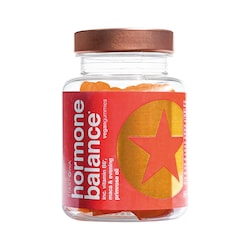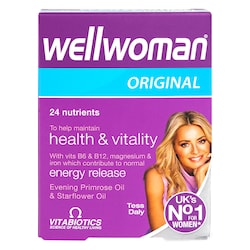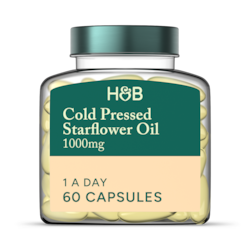15% off £30 OR 20% off £40
Code:CHOOSE
Ultimate guide to starflower oil: potential benefits, uses, side effects

Starflower oil is the rising star in wellness, but does it truly bloom with benefits? Let's look at what science has to say
Summary
1What is starflower oil?
Starflower oil comes from the seeds of the borage plant (or Borago officinalis to give it its formal name)...
2Possible benefits of starflower oil
So, what are the possible health benefits of starflower oil? We know that starflower oil – or borage seed oil – is packed with…
3What about the side effects of starflower oil?
Little has been found in the way of side effects of taking starflower oil as a supplement…
With claims to ease painful joints, promote skin health and help with weight loss – is starflower oil the unsung hero of the plant world?1-3
While the evidence behind these claims is anecdotal, some people feel the potential benefits make starflower oil worth adding to their wellness routine.
If you’re wondering if starflower oil is worth the hype, keep reading to learn about its possible benefits and find out whether there are any side effects of taking it. You’ll also discover some tips on how to easily incorporate it into your daily routine.
What is starflower oil?
Starflower oil comes from the seeds of the borage plant (or Borago officinalis to give it its formal name).4
The borage plant is often given the nickname ‘starflower’ due to its distinctive star-shaped blue flowers.5 So, you might hear starflower oil being referred to as ‘borage oil’ or ‘borage seed oil’.
Possible benefits of starflower oil
So, what are the possible health benefits of starflower oil?
We know that starflower oil – or borage seed oil – is packed with a substance called gamma-linolenic acid (GLA), an omega-6 fatty acid. In fact, starflower oil is nature’s richest source of GLA.4
Your body converts GLA into prostaglandin – a hormone-like chemical that affects several bodily functions.6 So, it’s no surprise that starflower oil is gaining hype as an ingredient that might support your wellbeing.
GLA has been connected to potential relief of joint pain caused by rheumatoid arthritis.7 What’s more, research indicates that administering topical borage oil containing high levels of GLA may support skin structure and function.2
Let’s delve into some of these supposed benefits – is starflower oil really the elixir du jour?
So, could starflower oil really be the answer to your stiff, achy joints?
Results of one study suggest that borage seed oil (containing GLA) may improve pain and function, and probably doesn’t increase unwanted side effects in people with rheumatoid arthritis (RA).7
In another small study, borage seed oil, fish oil and a combination of both were examined in people with rheumatoid arthritis with synovitis (inflammation of the tissue that lines your joints) over an 18-month period. Improvements were seen in all three groups and these continued across 18 months.8
A trial published in Arthritis & Rheumatism also investigated the use of GLA in the treatment of rheumatoid arthritis, showing a reduction in joint tenderness and morning stiffness in those affected by the condition.1 However, starflower oil isn’t approved in the United States for the treatment of any condition and further controlled studies of its use in RA are needed.1
Perhaps starflower liquid oil could make your skin the star?
Starflower oil contains high levels of certain essential fatty acids that are important for preserving the structure and function of the skin.9
A 2018 review of plant oils pointed to several possible benefits of borage oil for skin health.2 For example, for children with atopic dermatitis, borage oil was shown to normalise skin barrier function.10,1
Taking GLA (such as starflower oil) may also contribute to reducing lesions in people with acne. The authors of a recent study suggest that starflower oil may be a potential treatment for the condition.12
A study involving 45 women showed that a 2g daily supplement of borage oil may reduce skin redness (though no improvements were found for skin hydration, scaling or roughness).13
Starflower oil is unlikely to have any significant fat-burning effects.
However, research suggests the GLA in starflower oil could be helpful in reducing the risk of weight regain after weight loss. In one study, taking a daily 5g dose of borage oil helped 50 people who were previously affected by obesity to reduce the amount of weight they regained.14
Wondering if starflower oil may be the natural solution to reducing your PMS or menstrual symptoms?
Sometimes, the NHS recommends trying either starflower oil and evening primrose oil, both of which contain GLA, to potentially reduce breast discomfort connected with the menstrual cycle.15 Please note that it’s recommended to avoid starflower oil if you’re trying to become pregnant or taking blood thinners (see more in side effects below).15
The exact reasons why GLA may be able to help with breast pain aren’t really understood and current research is mixed on whether starflower oil can actually help with breast pain or not.15
One trial showed that women with cyclic breast pain who received a formula containing GLA plus iodine and selenium needed less over-the-counter pain medication and experienced reduced lumpiness of their breasts.16 However, it’s hard to say which of these components may have contributed to these positive results based on the study’s design.
What about the side effects of starflower oil?
Little has been found in the way of side effects of taking starflower oil as a supplement.
It’s possible that you may experience some unwanted effects, such as bloating, nausea, indigestion and headaches, but borage oil supplements are generally considered safe to use. However, as with any new supplements, always check with your doctor first before adding them to your routine.17,18
Starflower oil isn’t suitable for some people. There is a small risk of miscarriage with GLA – because of this, it’s important to avoid starflower oil if you’re trying to become pregnant.15
GLA can sometimes increase the tendency to bleed, so if you’re taking blood thinners (like as warfarin), you should speak to your doctor first before trying GLA.15
People with epilepsy are generally advised not to take starflower oil either.15,18
Getting starflower oil into your diet
Starflower oil comes in two forms:

- as a liquid oil
- in starflower oil capsules or soft gels
In the UK and EU, there is currently no recommended allowance or upper safe limit for starflower oil. Some NHS information leaflets provide advice for using starflower oil to ‘treat’ specific concerns.18
It’s worth checking the packet of any starflower oil product to ensure you know how much you’re taking.
The final say
One thing’s for sure – starflower oil has an enthusiastic fanbase. However, more high-quality research is needed to support the numerous wellness claims made about this seed oil.
Still, as it’s generally safe for most people to use17, many feel the potential benefits make it worth adding to their wellness routine.
The advice in this article is for information only and should not replace medical care. Please check with your GP or healthcare professional before trying any supplements, treatments or remedies. Food supplements must not be used as a substitute for a varied and balanced diet and a healthy lifestyle.
While we strive for accuracy and balance, please be aware that this article may discuss products available for purchase at Holland & Barrett. Consult a healthcare professional before making any health-related decisions.
- Zurier RB, et al. Gamma-linolenic acid treatment of rheumatoid arthritis. A randomized, placebo-controlled trial. Arthritis Rheum. 1996;39(11):1808–17. https://doi.org/10.1002/art.1780391106
- Lin T-K, et al. Anti-inflammatory and skin barrier repair effects of topical application of some plant oils. Int J Mol Sci. 2018;19(1):70. https://doi.org/10.3390/ijms19010070
- Schirmer MA, Phinney SD. Gamma-linolenate reduces weight regain in formerly obese humans. J Nutr. 2007;137(6):1430–5. https://doi.org/10.1093/jn/137.6.1430
- Asadi-Samani M, et al. The chemical composition, botanical characteristic and biological activities of Borago officinalis: A review. Asian Pac J Trop Med. 2014;7(S1):S22–8. https://doi.org/10.1016/S1995-7645(14)60199-1
- RHS. Borage [Internet]. [cited 2025 Jan 8] Available at: https://www.rhs.org.uk/plants/borage
- Fan Y, Chapkin R. Importance of dietary γ-linolenic acid in human health and nutrition. J Nutr. 1998;128(9):1411–4. https://doi.org/10.1093/jn/128.9.1411
- Cameron M, et al. Herbal therapy for treating rheumatoid arthritis. Cochrane Database Syst Rev. 2011;(2):CD002948. https://doi.org/10.1002/14651858.CD002948.pub2
- Reed GW, et al. Treatment of rheumatoid arthritis with marine and botanical oils: An 18-month, randomized, and double-blind trial. Evid Based Complement Alternat Med. 2014;2014:857456. https://doi.org/10.1155/2014/857456
- Wright S. Essential fatty acids and the skin. Br J Dermatol. 1991;125(6):503–15. https://doi.org/10.1111/j.1365-2133.1991.tb14786.x
- Tollesson A, Frithz A. Transepidermal water loss and water content in the stratum corneum in infantile seborrhoeic dermatitis. Acta Derm Venereol. 1993;73:18–20. https://doi.org/10.2340/00015555731820
- Kanehara S, et al. Clinical effects of undershirts coated with borage oil on children with atopic dermatitis: A double-blind, placebo-controlled clinical trial. J Dermatol. 2007;34:811–5. https://doi.org/10.1111/j.1346-8138.2007.00391.x
- Jung JY, et al. Effect of dietary supplementation with omega-3 fatty acid and gamma-linolenic acid on acne vulgaris: A randomised, double-blind, controlled trial. Acta Derm Venereol. 2014;94(5):521–5. https://doi.org/10.2340/00015555-1802
- De Spirt S, et al. Intervention with flaxseed and borage oil supplements modulates skin condition in women. Br J Nutr. 2009;101(3):440–5. https://doi.org/10.1017/S0007114508020321
- Schirmer MA, Phinney SD. Gamma-linolenate reduces weight regain in formerly obese humans. J Nutr. 2007;137(6):1430–5. https://doi.org/10.1093/jn/137.6.1430
- NHS. Royal United Hospitals Bath. GLA for breast pain [Internet]. [cited 2024 Sept 26]. Available from: https://www.ruh.nhs.uk/patients/patient_information/BRU016_GLA_For_Breast_Painpdf
- Mansel RE, et al. A randomized controlled multicenter trial of an investigational liquid nutritional formula in women with cyclic breast pain associated with fibrocystic breast changes. J Womens Health. 2018;27(3):333–40. https://doi.org/10.1089/jwh.2017.6406
- Martini N. Borage. J Prim Health Care. 2021;13(3):289–290. doi: 10.1071/HC19564
- NHS Worcestershire. Breast Unit. Patient Information Leaflet [Internet]. [cited 2024 Oct 16]. Available from: https://www.worcsacute.nhs.uk/~documents/patient-information-leaflets/breast-surgery/breast-pain-waht-cg-066-v1-9/































